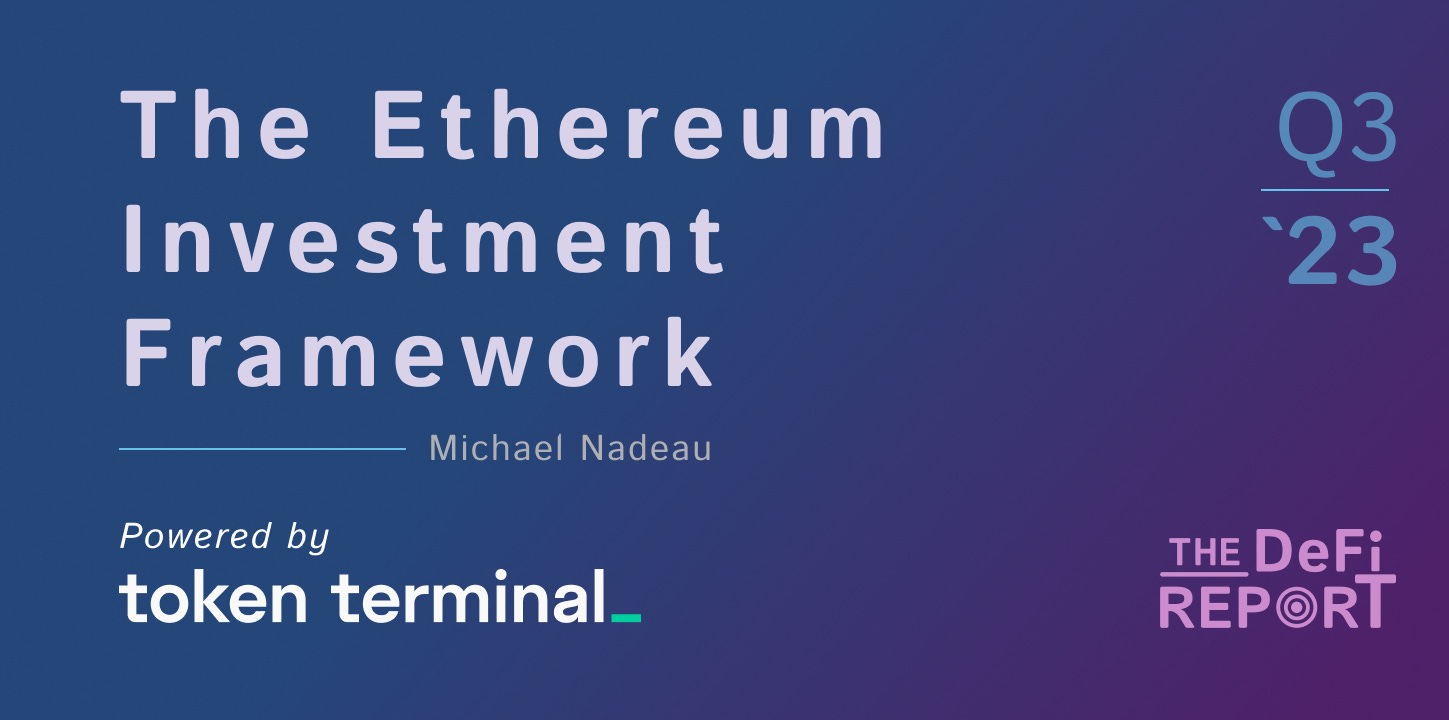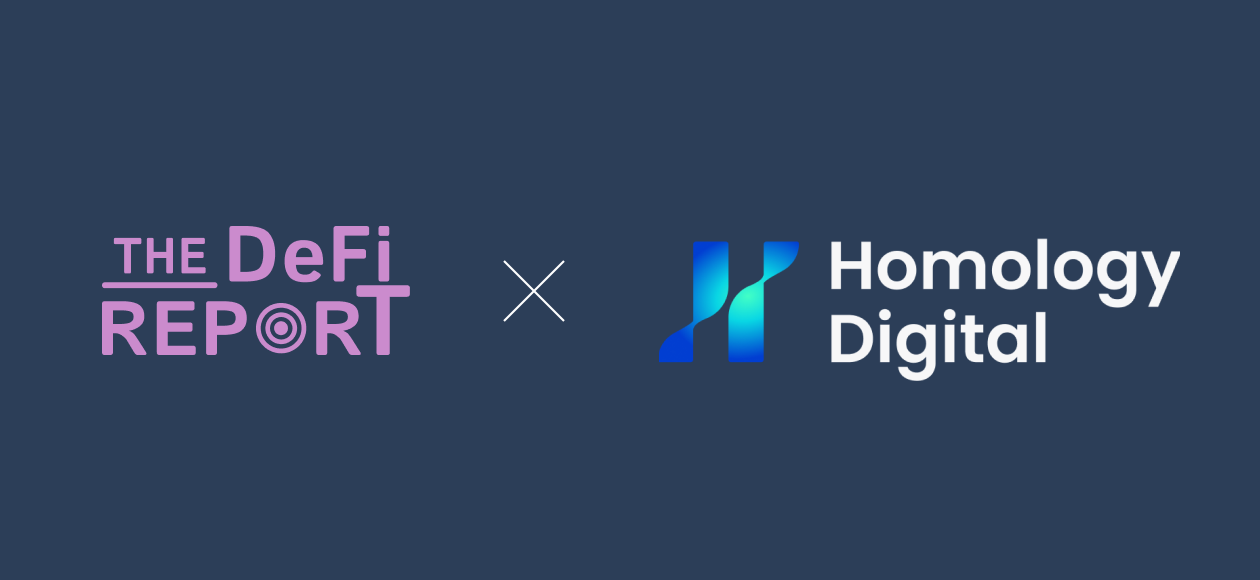The Ethereum Investment Framework is now FREE
The Q3 update is hot off the press. Download it now.
Hello readers,
The Ethereum Investment Framework is now FREE. It sold for $99.99 last quarter.
Special thanks to our friends at Token Terminal for providing the on-chain data that made the report possible.
In this week’s special edition of The DeFi Report, we are simply sharing the Executive Summary of the Q3-23 update of The Ethereum Investment Framework.
The DeFi Report is powered by Token Terminal. Subscribe for free data-driven research covering the Web3 tech stack from first principles & on-chain data.
Disclaimer: Views expressed are the author's personal views and should not be taken as investment or legal advice.
SPECIAL REQUEST THIS WEEK: Please like this post (heart button in the upper left of your email) AND share the download link of The Ethereum Investment Framework with your friends and colleagues (should you deem it worthy). As always, let’s make quality free content a win/win. This helps grow the community and responsibly introduce more people to DeFi and Web3.
Let’s go.
[via the Executive Summary of The Ethereum Investment Framework]
The internet is incomplete.
There is no denying that the web has brought us endless abundance. But it’s missing two critical components:
Internet users do not have digital property rights.
The internet does not have a credibly neutral, shared, secure, permissionless, global accounting system — to record the state of its users and enable global commerce on one shared ledger.
This is the core value proposition of public blockchains — which are installing a new data layer into the internet.
We take the concept of ownership and property rights for granted when it comes to our physical reality.
Yet we struggle to make the same connections to our digital lives. It’s helpful to pause and contemplate that which we truly own on the internet today.
We license books from Amazon. We rent music from Spotify and Apple. We even make payments to borrow web domains from a registrar. Our Twitter, Instagram, Facebook LinkedIn, and YouTube accounts can all be taken from us on a whim.
Never mind how our digital footsteps are monetized by others.
Our data is valuable. Yet we have no way of controlling access to it.
Crypto networks such as Ethereum bring the concept of property rights to the internet. We can think of this as user-controlled data via digital bearer instruments. The data comes in the form of both fungible and non-fungible tokens or crypto assets — controlled by users with digital wallets and private keys. [continued below]
Today’s issue of The DeFi Report is brought to you by Homology Digital. Their institutional-grade platform offers an intuitive solution for asset managers looking to integrate crypto and digital assets within investment portfolios. Homology not only simplifies the process but also ensures that portfolio managers have access to the essential tools and resources needed to effectively manage risk and maximize returns. Learn more here.
Please note that Michael Nadeau is an advisor to Homology Digital.
Given this breakthrough in computer science, it is worthwhile to contemplate the importance of property rights as the bedrock of any modern economy. Clear title to land — and the ability to own, control, and improve land is arguably what made the modern world possible. Just about everything else in the consumer economy is a consequence of this: accessing credit, the incentive for investment, unlocking “dead capital,” etc.
To drive home the concept, we’d ask you to ponder the last time you sent a PDF document as a bearer instrument. As in, when you sent it, the recipient now controlled it, and you no longer had access to it. You probably have no recollection of doing so — because it’s not possible today. But this is how crypto assets and NFTs work.
The reason that we cannot own anything on the Internet relates to #2 above: we do not have a credibly neutral, shared, secure, permissionless accounting database for the internet.
This means that the digital economy relies on centralized services to maintain the ledgers and the state of internet users across time. As a result, the economic activity of billions of individuals globally is recorded and stored by a handful of private Internet businesses — which control both the user interface and the database/accounting ledger.
While these problems are abstract to consider, the impact of solving them is potentially massive. To grasp the magnitude, we’d like you to consider the potential impact of a global ledger & computing platform such as Ethereum:
Can securely connect 8 billion people globally.
All the world's financial assets could be securely stored and transacted globally in a peer-to-peer manner on this ledger.
Has the potential to remake just about every business model on the internet via the introduction of smart contracts and digital property rights.
B2B interaction could be fundamentally transformed — with shared ledgers + automation via smart contracts (ERP for business interactions).
The global financial services industry could utilize this ledger for payments, trading, settlement, custody, lend/borrow, and ownership records.
Art, collectibles, music, gaming, brand loyalty/advertising, digital content, digital identity, social media, web hosting, and cloud computing business models could leverage this new ledger & computing platform — creating net new markets in the process.
This begs the question:
How much should this global ledger & computing platform be worth?
And what are the core concepts that an investor needs to understand to properly assess its potential value?
Things like the power of open-source technologies. Network effects. Lindy effects. Moore’s Law. Decentralized incentive structures. “Good enough technology” and “The 10-year window.” Why network technologies tend toward monopolies. The distinct phases that revolutionary technologies go through as they are implemented and deployed. The economics of Layer 2 solutions. The business model of each layer of the tech stack. Ethereum’s addressable market and “GDP.” On-chain financials, and much more.
Furthermore, what KPIs, metrics, and benchmarks should one be tracking?
How big is the addressable market? And what is the proper methodology to value a decentralized computing network?
The bottom line is that crypto is new. We haven’t seen this before. Furthermore, crypto markets and news cycles are full of noise. No matter where you turn, you will see wildly conflicting views on the space.
This is why we created The Ethereum Investment Framework.
It’s designed to save you hundreds of hours of research by combining everything you need to know into one document — in a non-technical, easy-to-navigate format.
We hope you find some value in it. If you do, please share the download link with your friends and colleagues so that more people can responsibly learn about crypto from first principles and on-chain data.
Download The Ethereum Investment Framework for FREE: The Ethereum Investment Framework
If you got some value from the report, please like the post (heart button in the upper left of your inbox), and share The DeFi Report with your friends, family, and co-workers so that more people can responsibly learn about DeFi and Web3.
This small gesture means a lot and helps us grow the community.
Finally, if you have a comment, thought, or idea, drop it here:
Take a report.
And stay curious.
Disclaimer: Individuals have unique circumstances, goals, and risk tolerances, so you should consult a certified investment professional and/or do your own diligence before making investment decisions. The author is not an investment professional and may hold positions in the assets covered. Certified professionals can provide individualized investment advice tailored to your unique situation. This research report is for general educational purposes only, is not individualized, and as such should not be construed as investment advice. The content contained in the report is derived from both publicly available information as well as proprietary data sources. All information presented and sources are believed to be reliable as of the date first published. Any opinions expressed in the report are based on the information cited herein as of the date of the publication. Although The DeFi Report and the author believe the information presented is substantially accurate in all material respects and does not omit to state material facts necessary to make the statements herein not misleading, all information and materials in the report are provided on an “as is” and “as available” basis, without warranty or condition of any kind either expressed or implied.



